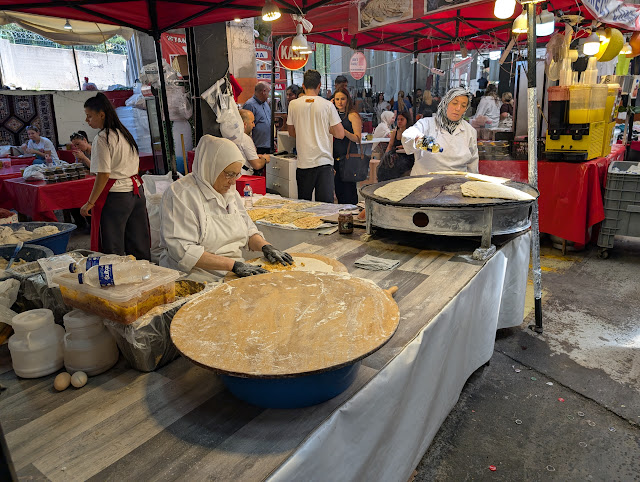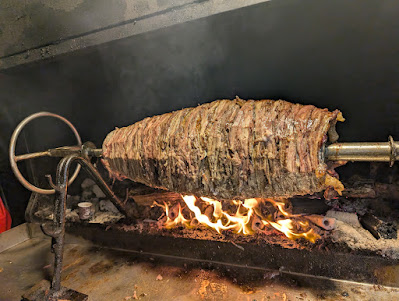We're heading home. It's been a relatively short trip back to the family homestead in New Jersey, a full four miles outside of New York City, just a Spanish bus ride down Route 4 away. We didn't go into the city very much this time. The main purpose was to be here for my Dad's 99th birthday.
Jack Cohen, US Navy veteran and retired Gold Shield New York City Police department detective is still sharp and fully operating at 100%. He is a bit shaky walking long distances and his career as a dancer of 1950s mambo and chacha are definitely over, but he still gets out to the Jersey meadowlands almost daily to go bird watching, which is a unique hobby for a former NYPD detective. He doesn't mess with the finches and sparrows much. He watches eagles and Ospreys, the big birds.

There are two things I miss about New York that I can't find in Europe: decent Cantonese Chinese food and Jewish style pastrami. Most of the "authentic Chinese" food we get in Hungary is straight out Beijing: dumplings, dumplings, and dumplings. For pastrami I have actually made it myself, which is messy and a ridiculous effort. Other than that Manhattan has changed so much since 9/11 that I don't have much use for it anymore. Gone are the quirky bookshops, the record stores, the oddball ethnic percussion shops, replaced by chain department stores selling sneakers to teenagers and Gucci to the luxury class.
 |
| Hand cut meats at Pastrami Bistro Grill |
For Jewish deli food, there are fewer and fewer real Jewish delis left. Liebman's in the Bronx, Pastrami Queen, and notable Pastrami master Freddie Loesser of the legendary and excellent (and closed) Loesser's Deli in the Bronx just passed away this month. Katz's Deli, which I have written about many times, has become a major New York tourist destination, with long waiting lines (people say to go late at night if you don't like lines) The pastrami sandwich at Katz's is now $32.00, which sounds like a lot but it is the best in the world (alongside Schwartz' Smoked Meat in Montreal) and 32 bucks generally won't get you far in New York anyways. We opted to stay in Jersey, and went to the Pastrami Grill Bistro in Garfield.
 |
| Brisket Sandwich, Garfield, NJ |
Where I am a hardboiled pastrami guy, Fumie loves beef with a pure beefy flavor, so she ordered the brisket sandwich. It was fourteen dollars. Less than half the New York price these days. It was fantastic. Same texture and consistency as the corned beef and pastrami but without the spicing. I may become a fan of brisket sandwiches in the future. They are certainly easier to make in home recipe version than pastrami, although finding the right cut of beef in Hungary is going to require negotiation with a butcher. Butcher cuts in Hungary are entirely different from those in the USA.
 |
| Classic $8 Wonton Noodle at 218 Grand street. |
I have nothing against taking the 7 train all the way to Flushing for New York's widest selection of regional Chinese food, but for Cantonese food Manhattan's Chinatown still rules. In my younger days I used to underwrite trips to the city by economizing on food: I ate almost exclusively Hong Kong style wonton noodle soups, which used to be the cheap option for a meat and soup dinner under five dollars. Today that has doubled. A lot of the cheap noodle soup and congee places that used to sell chopped Cantonese BBQ meats have disappeared along with the sweatshop clothing industry that supported them until recently.
 |
| Giant wonton and noodle in duck soup with beef tendon at Maxi's. |
In their place a new generation of wonton noodle soup houses have opened up. I had read about Maxi's Noodle, which specializes in the old Hong Kong style noodle soups. They used to be one of the only Cantonese places in Flushing. The daughter of the original owner took it over and made a hip atmosphere and preserved the family tradition of making some of the largest shrimp and meat wontons in the city. I had to go. Fantastic, and worth the price.
 |
| Grandmas Rulez at Mott Street Food Court |
Chinatown used to be the home of massive dim sum parlors, many of which, like the legendary
Jing Fong, reputed to have had New York's largest single dining room,
have closed down due to greedy lanlords and real estate managers. The newly opened Mott street Food Court, however, seems to have plugged the hold. There were no tourists to be seen, instead the tables were filled by seemingly vagrant Chinese Grandmothers shouting across the room in Cantonese. Perfect. Jackpot!
 |
| Rice rolls, shiu mai, turnip cake, tofu skin rolls. |
This isn't a classic Dim Sum spot: there are no servers pushing carts piled with bamboo steamers around the food (you can still find that in Queens.) There are several stalls selling everything from bubble tea to Taiwanese beef noodle soup, but we chose to order Dim Sum, which came in plastic trays.
 |
| Teochew dumplings |
About a quarter of the old Chinatown population comes from Teochew, a region in eastern Canton bordering Vietnam that speaks its own form of
Min Chinese (instead of the
Cantonese Yue language of Guangdong) and became to source for the majority of Chinese emigrants to southeast Asia. Teochew food shares a lot of flavors and techniques with Vietnamese and SE Asian food, and we usually have a go at
Bo Ky, which is still one of the most affordable joints in New York. Here on Mott Street they had Teochew dumplings: wrapped in a soft gooey rice and mugwort coat and containing a mix of mystery meat, peanuts, and scallions.
We came back for the Teochew dumplings with my son Aron and Chi, who had already eaten when we met them so they missed out. Perhaps because the night before Aron had gone with us to Fort Lee, NJ, for shanghai style food at Soup Dumplings Plus, one of the few Chinese restaurants in the overwhelmingly Korean part of Bergen County next to the George Washington Bridge.
The Soup dumplings were excellent, and that says a lot since I was never sold on the soup dumpling craze. We finished our trip with a family tradition - the mamaliga and seafood feast. My Dad's family came from Moldavia, and while growing up poor in New York in the great depression during the 1930s, my Grandmother would rely on that old Romanian staple, mamaliga, (which is essentially cornmeal mush, or more elegantly, polenta) to feed her four children.
 |
The Cohens: Fran, Jerrie, Jack in baseball cap, Grandma, Eli around 1938
|
Dad still craves mamaliga, and I make it for him when I am around, especially as a side dish to shrimp creole. Dad has to watch his sodium and potassium these days, so okra subs for tomatoes and shrimp has enough flavor to not need salt. My Dad also introduced me to clams on the half shell when I was about twelve years old, possibly as a hedge against me becoming increasingly kosher as I entered the bar mitzvah study stage (clams, indeed, any shellfish, are not considered kosher.) I introduced my son to clams when he was around 9, and he has been sucking them down ever since as well. So here it is: three generations of Cohens, integrating the traditional with the modern.
Seafood and mamaliga!



























